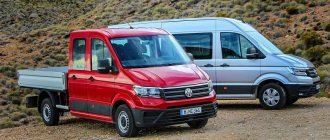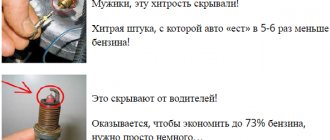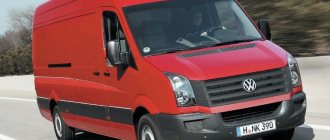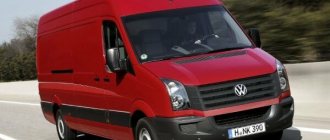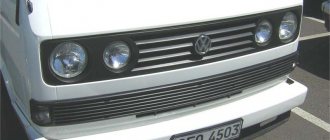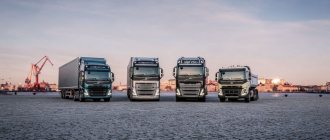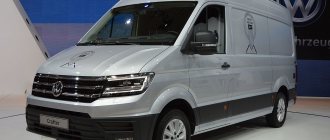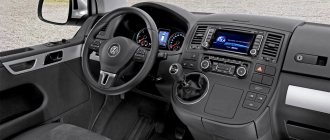Home Brands Volkswagen Volkswagen Crafter 1
Volkswagen is an indicator of quality in the understanding of the Germans. They know what they want, so they presented a whole Volkswagen series. The Germans began working on the Volkswagen Crafter, which took 3 years. They brought in engineers who worked on the Caddy and Transporter T5. Manufacturers had high hopes for the technology.
Cars began to be produced in 2006, the story does not end there. New models began to appear in 2016. But let’s focus on this 2006 car, which managed to establish itself on the positive side.
Appearance
The car was developed in Ludwigsfeld, on. The owners of the concern pursued high goals: reducing fuel consumption, comfort, and necessary functions. As soon as the car appeared on the roads, it was immediately noticed. The appearance inspires confidence.
The department that deals with car production issues has created a unique platform, on the basis of which many configurations have been produced. The appearance of a “gazelle” is no longer to the taste of drivers. Some technical specifications are underwhelming. How to interest consumers? Geometric shapes, spaciousness, load capacity, price. German manufacturers have found what everyone dreams of. The existing developments made it possible to understand what the driver needs.
The appearance and interior of the cabin speak about the quality of the German car. The model looks modern and has its own flair. The body can be seen in 4 versions:
- Cargo all-metal structure;
- Utility vehicle (2-9 seats);
- Passenger car;
- Flatbed truck.
With any body of the 1st generation Volkswagen Crafter, the main conditions are met - high safety for passengers and drivers. Standard technology is highly resistant to impact. There is a Hill Hold Control function that helps when starting.
The standard equipment is characterized as follows:
- length – 586.5 cm;
- width – 199 cm;
- height – 235.5 cm;
- wheelbase - 366.5 cm;
- minimum turning diameter – 1230 cm;
- weight – 1681 kg;
- load capacity – 2.5 tons;
- highest speed – 142 km/h.
Test drive Volkswagen Crafter
Agree, it’s not often that you see the same car in three versions at once: front-wheel drive, rear-wheel drive and all-wheel drive...
THEY LOOK THE SAME When, in the late 1990s, the Gorky Automobile Plant tried to put three versions of the new Volga 3111 on the assembly line at once - in rear-wheel drive, front-wheel drive and all-wheel drive versions, with engines lengthwise and crosswise, this was perceived with a sarcastic grin. Doubts about the seriousness of GAZ's intentions were raised by the attempt to combine fundamentally different layouts in one body. Many years have passed since then, but every time I hear about such projects, the first thought that comes to mind is - are they serious or joking? However, the Germans from Volkswagen, apparently, do not like to joke, and since they said “three types of drive, three base lengths and three body heights,” then so be it. Moreover, having built the fourth, counting from the first commercial LT, and the second generation of the Crafter, they moved away from cooperation with Mercedes-Benz and made a commercial vehicle on their own, discarding many “foreign” solutions such as a transverse spring at the front. Engineers from Wolfsburg and Hannover simplified the design extremely, using the usual MacPherson... In general, a good delivery vehicle is always a small masterpiece, and in the depths of the current VW Crafter there are a lot of interesting things hidden, but until you get under its belly and look under the hood, there are really no differences with its predecessor and you won't see. But it really does exist and is based primarily on a large-scale survey of potential clients, each of whom needs their own Crafter, tailored to the specific operating conditions.
WAGING THE TAIL Electronics are increasingly robbing the professional driver of his skills and ingenuity. A simple automatic parking system will no longer surprise anyone, so Volkswagen engineers taught the car to independently control a road train when moving backwards. The driver sets the desired position of the virtual trailer on the monitor screen, and Trailer Assist independently rotates the steering wheel so that the real trailer takes the specified position. The picture is superimposed on a real image of the area - it is impossible to make a mistake. The function is activated automatically as soon as the trailer light plug is connected to the towing device connector
NOT A CAR, BUT A CONSTRUCTOR There is nothing surprising in the fact that commercial vehicles are assembled exactly according to the client’s preferences. The Germans are well acquainted with Russian classics and, having once read the famous phrase from Gogol’s “Marriage”: “If I could put Nikanor Ivanovich’s lips on Ivan Kuzmich’s nose... and, perhaps, add to this the portliness of Ivan Pavlovich, then I would immediately decide,” They took it as a guide to action and came up with such a variety of layouts and weight loads on the rear axle that objectively they turned out to be completely different cars. For the buyer - freedom, but for us - the problem is: which one to choose, how to describe dozens of basic modifications of the Volkswagen Crafter. Do you doubt their number? Let's count. To begin with, let’s multiply the three types of drive by three body lengths (5.9, 6.8 and 7.2 m), by two base lengths (3.64 and 4.49 m) and by three roof heights (2.3, 2.6 and 2.8 m). This is already 54 versions. And since the car is available with four variants of a two-liter turbodiesel (102, 122, 140 and 177 hp), we multiply by four more, which gives a downright astronomical number. But there are also options with single and double rear wheels, with manual and automatic transmissions, special versions and a traditional Volkswagen wide range of additional equipment. At the same time, the initial configuration is an almost empty iron box with a minimum of comfort. But let's go back to the car, because this is where the most interesting thing awaits us... And it's time to finally choose which version we will talk about.
An unusual small steering wheel in the interior of a huge van seems to hint: “the driver will not overwork here”
HALDEX-BRIDGE Surprise, surprise! If the configuration of a rear-wheel drive car with a longitudinal engine is as clear and obvious as a front-wheel drive car with a transverse engine is natural, then the all-wheel drive version with a plug-in rear axle has aroused enormous interest for only one reason - its power unit is positioned transversely. Yes, yes, the Germans decided to make their all-terrain vehicle with an almost crossover layout and dominant front-wheel drive. But how can you take the torque back so that it can be turned off, given that there is only a simple gearbox inside the standard front differential? Yes, it’s very simple - attach a Haldex coupling to the spring bridge and get... the first bridge in history with a disconnection directly in it. Simple and effective - in the front, standard units with a conventional rear power take-off gearbox have been preserved, and in the rear, the vehicle has become as heavy as possible, since it uses a spring axle. The drive system itself is standard for VW 4Motion, which is rather good because it is familiar and understandable. Transmission options include a six-speed manual and eight-speed automatic. By the way, in the rear-wheel drive version, the trucks have double rear wheels and a maximum weight of 5 tons.
A four-cylinder diesel engine with a gearbox drowns in the depths of a huge engine compartment. They fit here both lengthwise and crosswise.
FROM TOP TO BOTTOM OLIQUE For the test, we chose an empty van with blank walls, which the Germans call a “panelvan”. We have an average base length of 3,640 mm and a high roof. You can not only walk without bending down, but even wave your arms above your head - you still won’t be able to reach the ceiling. Just this one, but only long-wheelbase and in the simplest version, will be in maximum demand in our country, since most of its potential owners will want to cut in the windows, put cheap seats inside and send them to replace the current IVECOs as minibuses. An unenviable prospect? Perhaps, because the majority of its Russian buyers have not read “Marriage” and will be guided exclusively by the material side of the issue when choosing equipment. Well, let's imagine a different fate - a van for transporting furniture or even ATVs and motorcycles. Again, this is still the same truck with blank walls and a minimum of equipment. Our other versions are only a small fraction of the mass of numerous commercial carriers. But in Russia, and in Europe the picture is the opposite. There, vans are fully engaged in delivering small consignments of goods, and work in farming, repair and other businesses. They are also used as mobile laboratories, and overseas there is a growing demand for campers made from the same “panelvan”... In general, the plant has room to expand, offering a variety of configurations and configurations. But, since the basis of future sales is still our iron “panelvan”, we’ll talk about it.
If you don't know how to park with a trailer, Volkswagen's automatic system will help you. And it will even tell you where and what to click
Before we find out how it drives, let's slide the huge side door open to reveal 1,311mm of free space. This is sufficiently large enough for the loader to place a standard pallet inside without fear of hitting the opening. And the body itself is simply huge - the height of the cargo compartment is 2,196 mm. Moreover, in the front-wheel drive version it has an additional 10 mm of height due to the lower floor. Alas, the rear- and all-wheel drive versions have a higher floor, but the internal volume is still amazing. Nothing protrudes inside the body except the wheel arches; all surfaces, including the roof, are equipped with strips with numerous fastening points for clamps. With their help you can secure any load. There is interior lighting, niches, and volumes for standard heaters and air conditioning. The first can be placed in a special recess under the driver and passenger seats. The second is mounted in the roof of the cabin and, with the help of air intakes, is capable of operating as an entry-level cooler for, for example, transporting flowers. It is clear that if we are talking about a powerful air conditioner, it will still have to be embedded into the back of the roof, but even this one will cope with ordinary heat. This design is somewhat reminiscent of the interior ventilation system of the first Volkswagen Bulli, where in the same way a box passed over the driver with life-giving coolness for the languishing passengers behind.
That's what it all started for - a huge body with the largest openings in the class
SOLID TRANSPORTATION In terms of suspension, the new Volkswagen Crafter is a noticeably stiffer car than its predecessor. And if on smooth asphalt this is not so noticeable, then, as soon as you drive onto gravel or a bad road, it shakes from the heart. Of course, a loaded van rides more smoothly. The electric power steering made it possible to connect a lane following assistant to it, which first unobtrusively counters several fluctuations within the lane boundaries, and if they continue, then, deciding that the driver has fallen asleep, it sounds an emergency signal. Although the automatic still sometimes malfunctions and even on fairly clear European markings continues to return the car to the line, despite the fact that the turn signal is on and the driver is trying to change lanes. Perhaps the error lies in the algorithm for compensating for the transverse slope of the road (this steering wheel also has one) and the “electronic steering wheel” is too eager to handle small slopes.
On the autobahn, another property of the suspension appears - unpleasant galloping, accompanied by noticeable longitudinal pitching. It is clear that ideally such a car should not drive empty on the highway, but still, with a small load, which can be the same motorcycle, its weight is not enough to smooth out these bucking and make the van comfortable. The factory provides six levels of suspension stiffness, including a special comfortable one. We probably had one of the best route options for glass-smooth German roads. The rest of the car is quite up to par. Of all the versions of the two-liter engine, only one, the least powerful (102 hp), makes fast overtaking problematic. The boxes work perfectly! In a manual gear, the first gear is cargo. It is also suitable for crawling off-road, and on asphalt and with partial load you can start with the second one.
At high speeds, the Cross Wind Assist system works well, preventing the tall car from swaying when passing an oncoming truck. The effect of the air strike is reduced by what feels like two-thirds, and instead of a sideways throw, there is only a slight rocking motion without the need to steer.
STONES, CLAY, SLOPE
Of course, we did not drive a commercial van into forest ruts, but we did drive through clay and gravel deposits in a quarry. Not just like that, but with a one and a half ton trailer. In this version, the limiter of cross-country ability is not the geometry of the car or the articulation of the suspension, but the minimum speed of the turbo engine at which it is capable of driving. Steep climbs in a loaded Volkswagen Crafter must be navigated using the good old rule: let the turbo blow. In other words, not allowing the engine to reduce speed below 2000. Otherwise, there will be a sharp blow, and the manual car will stall. True, the automatic handbrake, which holds the slope for three seconds, and that same creeping first gear, ready to cope with any slope, helps to get going uphill. The rear drive axle is equipped with a forced lock, and in addition, the car is trained to “crackle the brakes”, simulating cross-wheel locks using the ASR system. In a word, at the very least, we drove along the road for quarry trucks. For, in fact, asphalt delivery vehicles, this is quite enough.
ENDLESS COMFORT But what the Volkswagen Crafter has in abundance is comfortable options, and by delving into the brand’s configurator, you can easily double the price of any car - despite the fact that none of the options will be superfluous. In general, an eloquent confirmation of the phrase “you have to pay for comfort” is evident here. But a lot is given to the buyer as standard. For example, LED lights and an automatic post-collision braking system that prevents the worst-case scenario from developing. The rest of the radar add-on is available for money. It includes monitoring of the front sector of the car, including an emergency braking function at the command of cameras, monitoring of the occupancy of adjacent traffic lanes, automatic perpendicular parking and a trailer parking assistant. In addition, as additional functions there is a new generation of adaptive cruise control (ACC), a lane tracking system and side protection parking sensors in the doors to prevent sideways collisions with obstacles in sharp turns. The list of additional factory equipment also includes a standard 220 V inverter.
AN EXCITING WORLD OF ENTERTAINMENT At just above the minimum trim levels, instead of the standard LCD radio, an infotainment system with an 8-inch touch screen, an Apple USB-compatible mobile phone interface, voice control and the App-Connect Crafter application is available. It can connect to iOS and Android smartphones, uses navigation and phone apps, and is configured to digitally manage commercial vehicle fleets.
BOTTOM LINE From the point of view of the usual idea of SUVs and crossovers, cars such as the all-wheel drive Volkswagen Crafter can be positioned as equipment standing at the very edge of the 4x4 world. However, nevertheless, it has high chassis strength, almost twenty-centimeter ground clearance, and even standard protection for the motor and rear axle gearbox (about 100 thousand rubles). It’s hard to call it an SUV, but if you compare the cross-country ability of a van with the most all-terrain crossovers, then it is at least no worse. This means that those who, for example, take a team of cross-country motorcycles to the competition site, now have another vehicle, and it is very reliable, economical and advanced in engineering. In general, we liked this van, and as soon as the cars appear in Russia, we will be happy to drive it along our native roads.
TECHNICAL DETAILS The Volkswagen Crafter is built on a steel frame to which the body or cab is attached. The front part of the cabin with the driver's seat is built using passenger car technology using steel of variable thickness. The engine compartment is designed to be very spacious, allowing the engine to be positioned both lengthwise and transversely. There are three types of drive - front, rear and all-wheel drive. The all-wheel drive vehicle has a transverse power unit and a leaf spring rear axle with a Haldex coupling. The front suspension of all versions is MacPherson strut. Depending on the power, the range of engines includes units with single and double supercharging. The cooling system is three-circuit, with a separate liquid supply to the cylinder head and block.
Cabin interior
The car's seats and the interior as a whole deserve attention. It is worth noting that they are quite comfortable. Comfort makes you feel great.
The steering wheel in the car is comfortable. He regularly fulfills the driver's requirements. There is a reach adjustment, but you need to make an effort to press the signal.
The interior space can be distributed intelligently. The driver can place all the necessary parts in the car. The first generation equipment was assembled on the same assembly line with its main competitor - the Mercedes Sprinter. The designers tried to eliminate the similarity of the two cars. The rear of the cars turned out to be very similar. The front part has no similarities. The front part adds audacity and brutality to the car, this is not found in Mercedes.
Engine and gearbox Volkswagen Crafter 1st generation
Previously, the cars had one engine - a 5-cylinder 2.5 TDI turbodiesel with direct injection. There are 4 power levels:
- 89 l/s;
- 109 l/s;
- 136 l/s;
- 164 l/s.
The engine's objectives are good traction and reduced fuel consumption. This is ensured by the DPF filter. There is a 6-speed manual transmission with a lever on the center console. Additionally, an automatic transmission can be installed.
After 2011, the engine was adjusted. There are now 2-liter TDI engines. Engine power:
- 109 l/s;
- 136 l/s;
- 163 l/s.
The motors comply with environmental standards - Euro-4 and Euro-5. Not all car owners consider these standards important. Since it is really not clear whether there is a result.
Second generation (Typ SY/SZ, 2022–present)[edit]
The second generation of the Volkswagen Crafter was developed entirely by Volkswagen after the end of its collaboration with Mercedes-Benz. The new design follows the current Volkswagen design and is available in Startline or Trendline trim levels. The motorhome variant, called the Volkswagen Grand California, was first shown at the Caravan Salon 2022 in Dusseldorf. [12] Grand California comes in two varieties; 6.0 meters (600) and 6.8 meters (680) went on sale in early 2022.
The second generation Crafter is being built in Września, Poland, and a new plant is being built specifically to produce it. The planned volume is 85,000 cars per year on an area of 220 hectares (300,000 square meters under the roof). The cost of the new plant was approximately PLN 3,381 million. [13]
Engines[edit]
| Engines (2017–) | ||||||
| Model | engine's type | Power | rpm | Torque | rpm | European ejection standards |
| 2.0 TDI CR | 1968 cc cc (120 cu in) I4 turbocharged | 109 hp (80 kW; 108 hp) | 3500 | 300 Nm (221 lb-ft) | 1500–2250 | Euro 6 |
| 114 hp (84 kW; 112 hp) | 3500 | 300 Nm (221 lb-ft) | 1500–2250 | Euro 6 | ||
| 140 hp (103 kW; 138 hp) | 3500 | 340 Nm (251 lb-ft) | 1575–2250 | Euro 6 | ||
| 2.0 BiTDI CR | 163 hp (120 kW; 161 hp) | 3600 | 400 Nm (295 lb-ft) | 1800 | Euro 6 | |
e-Crafter [edit]
In September 2016, Volkswagen presented the all-electric e-Crafter van at the IAA commercial vehicle show in Hannover. The e-Crafter concept is equipped with a 43 kWh battery that provides an estimated range of 208 km (129 miles). The van has a payload of 1,709kg and cargo space of 11.3 cubic metres. The E-Crafter is powered by an electric motor producing 100 kW and 290 Nm, and top speed is limited to 80 km/h (50 mph). [3] The electric van is ready for production, with retail deliveries scheduled for 2017. [3]
Great California [edit]
At the 2022 IAA Frankfurt Motor Show, Volkswagen presented the California XXL motorhome concept based on the Crafter. The 6.2 m long vehicle is 2.2 m high and is equipped with underfloor heating. The production version was named Grand California and the model went on sale in 2022. It is a large version of the Volkswagen Transporter based on the Volkswagen California.
MAN TGE [edit]
The second generation Crafter is also sold by MAN Truck & Bus as the MAN TGE. MAN is a brand of TRATON, the heavy commercial vehicle division of the Volkswagen Group. The MAN TGE has a wide range of body styles: the van is mainly sold as a van, but is also available as a tipper, side dump or crew cab. [14]
- Second generation Crafter front end
- Rear Crafter second generation
- Second generation Crafter dashboard
- MAN TGE
Crafter Chassis
At the front of the car there is an independent suspension with a single-leaf fiberglass spring, a hydraulic shock absorber with a transverse stabilizer. At the rear there is a continuous axle secured with leaf springs.
The equipment has ventilated disc brakes. They get the job done the way it needs to be done. Only the key factors were different:
- load capacity (from 3,500 kg to 5,500 kg);
- base length in 3 varieties;
- roof height;
- body types (4 in total).
It’s not for nothing that the truck was made so functional. The 1st generation Volkswagen Crafter is needed not only by small businesses, but also by private owners. Behind the configuration lies many possibilities: transportation of goods, transportation of passengers.
Links[edit]
- “Daimler seeks to expand partnership with Volkswagen | Reuters". UK.reuters.com. September 9, 2012. Retrieved July 20, 2013.
- "VCDS VW LT3 Software Diagnostic Tool" (in German). Archived from the original on February 11, 2013.
- ^ abc Kane, Mark (September 24, 2016). "Volkswagen Unveils Electric e-Crafter Van: 124 Mile Range, Arrives 2017". InsideEVs.com. Retrieved September 24, 2016.
- "2017 Volkswagen Crafter". August 1, 2016. Retrieved November 1 +2016.
- "New 2022 Volkswagen Crafter van launches with new look and more technology". September 8, 2016. Retrieved November 1 +2016.
- "New 2022 Volkswagen Crafter Debuts with FWD Option, US Market Entry Possible". July 28, 2016. Retrieved November 1 +2016.
- "All-New 2016 VW Crafter Revealed in Full". September 9, 2016. Retrieved November 1 +2016.
- “FIRST PHOTOS AND RELEASE DATE OF MAN TGE CONFIRMED.” August 11, 2016. Retrieved November 1 +2016.
- "Volkswagen Crafter - Un utilitaire de métiers" (in French).
- ^ abc "Volkswagen Crafter - Engine Specifications". Volkswagen Commercial Vehicles
. Volkswagen-Vans.co.uk. Archived from the original on January 11, 2010. Retrieved November 11, 2009. - "Volkswagen Caddy Maxi and Crafter Chassis Cab Awards - Easier to Drive". Easier
Inc. Easier.com. April 18, 2008. Retrieved November 11, 2009. - Rihanna
Evans, Gareth (24 August 2022).
“Stars of the Campervan show – highlights from the Caravan Salon Dusseldorf 2022 | Parkers". www.parkers.co.uk
. Retrieved March 2, 2022. - "We Wrześni powstanie nowa fabryka Volkswagena". finance.wp.pl
. March 18, 2014 - "THE MAN"
Malfunctions
You can learn about malfunctions and negativity from driver reviews. There are both negative and positive reviews.
On European roads, problems with a car begin after a mileage of 200,000 thousand. On Russian roads, problems with breakdowns begin after a mileage of 80,000 km.
In Europe, the fuel distribution system begins to have problems after 3 years of active use, and in Russia a couple of months after purchasing a car.
Crafter's first problem is corrosion. Drivers say it is starting to appear in many places. The crosspieces are not reliable, they do not need lubrication after 55,000-60,000 km, they need to be changed immediately. Steering tips, stabilizers - all this does not withstand Russian roads.
But between this the car declared itself on the positive side. Still difficult conditions. If you take proper care of your car, it will last much longer.
It is important to read the car's owner's manual. It is necessary to send equipment for maintenance on time. Repair work should be entrusted to reliable service centers. The employees there know exactly how the car works.
Prices for Volkswagen Crafter 1st generation
If we consider used cars, their cost starts from 350,000 rubles. The final price is affected by the year of manufacture, the specific model, and the condition of the car. With the basic configuration, the car should have this:
- 1 airbag;
- power steering;
- exterior mirrors + heating + electrically adjustable;
- ABS, EBD, ESP;
- audio preparation.
There are many other additions. And the new model costs from 1,600,000 rubles with basic equipment.
The first generation Crafter will be in demand for many years to come. And there is a simple explanation for this - it is superior to its competitors in many ways. Drivers report many benefits.
